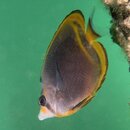klausi
Contributor
I am diving regularly in the Sydney area, and I am observing that at this time of the year, the beginning of winter, we still have a lot of subtropical and tropical marine animals around, and none of the usual winter visitors, like the Port JAckson sharks or the seals near Wollongong. I think this is connected to the building El Nino we are having this year. I wrote about these observations in more detail in my blog. Enjoy! Is anyone else in other areas making similar observations?
This is a - quite tropical - butterflyfish I have been seeing in Sydney waters for a while now - the coloration on the shot is it's night color. Can anyone ID the fish?

This is a - quite tropical - butterflyfish I have been seeing in Sydney waters for a while now - the coloration on the shot is it's night color. Can anyone ID the fish?





